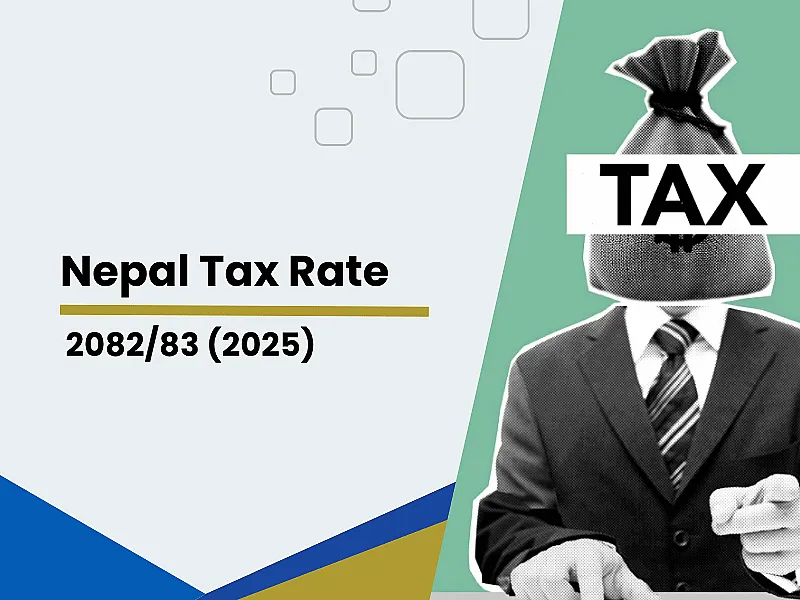
Table of Contents
The Income Tax Rate in Nepal for the fiscal year 2082/83 (2025) is a crucial reference for every citizen, employee, freelancer, and business owner. With the latest budget speech presented by the Finance Minister of Nepal, there are several updates regarding tax slabs, exemptions, and taxable income limits.
Budget Highlights of Nepal 2082/83 (2025)
The Government of Nepal announced the annual budget for 2082/83 with a focus on:
- Economic recovery and growth
- Tax simplification
- Increased revenue generation
- Support to small businesses and agriculture sector
Key Budget Takeaways:
- No drastic change in personal income tax slabs.
- Focus on widening the tax net rather than increasing tax rates.
- Introduction of new digital services tax.
- Increase in excise duty on luxury goods.
- Tax incentives for startups and SMEs continue.
- PAN card mandatory for more transactions to curb tax evasion.
Maximum Taxable Income in Nepal for 2082/83 (2025)
The maximum tax rate for personal income remains capped at 36%, applicable to high-income earners.
| Income Range (NPR) | Applicable Tax Rate |
|---|---|
| Up to NPR 5,00,000 (individual) | 1% optional flat tax or normal slab |
| Above NPR 5,00,000 to NPR 20,00,000 | Normal slab applies (see below) |
| Above NPR 20,00,000 | Up to 36% depending on income |
Key Insight:
Individuals earning over NPR 20 lakhs annually will face maximum 36% tax, similar to previous years.
Income Tax Slabs in Nepal for Individuals 2082/83
For Unmarried Individuals:
| Annual Income (NPR) | Tax Rate |
|---|---|
| Up to 5,00,000 | 1% or normal slab (see next row) |
| First 5,00,000 | 1% optional or 10% |
| 5,00,001 – 7,00,000 | 20% |
| 7,00,001 – 20,00,000 | 30% |
| Above 20,00,000 | 36% |
For Married Couples:
| Annual Income (NPR) | Tax Rate |
|---|---|
| Up to 6,00,000 | 1% optional flat tax or 10% |
| 6,00,001 – 8,00,000 | 20% |
| 8,00,001 – 20,00,000 | 30% |
| Above 20,00,000 | 36% |
Tax Rate for Companies in Nepal 2082/83
| Company Type | Tax Rate |
|---|---|
| Normal Companies | 25% |
| Banks and Financial Institutions | 30% |
| Telecom, Insurance | 30% |
| Cigarette, Liquor Companies | 40% + additional excise |
| Information Technology (IT) Export Companies | Reduced rates, starting from 20% |
Comparison: Tax Rate 2082/83 vs 2080/81
| Category | 2080/81 Tax Rate | 2082/83 Tax Rate | Change |
|---|---|---|---|
| Individual (Up to 5L) | 1%/10% | 1%/10% | No change |
| Married Couple (Up to 6L) | 1%/10% | 1%/10% | No change |
| Maximum Tax Rate | 36% | 36% | No change |
| Company Tax | 25%-40% | 25%-40% | No change |
| Digital Services Tax | Newly Introduced | Applicable | New Introduction |
Optional 1% Tax: Should You Choose It?
If you:
- Have no other taxable income,
- No business income,
- Only salary or pension under NPR 5,00,000 (individual) or NPR 6,00,000 (married),
You can opt for 1% optional tax, meaning no need to file tax returns or maintain books of accounts.
Example: Income Tax Calculation for Salaried Person 2082/83
Scenario 1: Ram earns NPR 8,00,000 annually (Unmarried).
| Income Slab | Rate | Tax Amount (NPR) |
|---|---|---|
| Up to 5,00,000 | 10% | 50,000 |
| 5,00,001–7,00,000 | 20% | 40,000 |
| 7,00,001–8,00,000 | 30% | 30,000 |
| Total Tax Payable | 1,20,000 |
Key Compliance Updates in 2082/83
- Mandatory PAN Card for salaries above NPR 25,000/month.
- Digital service providers like YouTube earners, social media influencers, freelancers must register and pay taxes.
- No significant increase in tax rates, but stricter enforcement and compliance.
Important Tax Deadlines Nepal 2082/83
| Activity | Deadline |
|---|---|
| Individual Tax Filing | End of Ashadh (mid-July 2025) |
| PAN Registration | Before starting employment/business |
| Advance Tax Payment (Installments) | Quarterly basis |
| Final Tax Settlement | End of Ashadh each fiscal year |
Common Questions on Nepal Tax Rate (FAQs)
1. What is the maximum taxable income in Nepal 2082/83?
The maximum personal tax rate applies beyond NPR 20 lakh, capped at 36%.
2. Is there any change in tax rates in 2082/83?
No major rate change. Compliance requirements have tightened.
3. What happens if I don’t file taxes on time?
Penalty of NPR 5,000 to 10,000 minimum, plus interest on due taxes.
4. Do freelancers and YouTubers need to pay tax in Nepal?
Yes, as professional income under IRD rules.
5. Can I use the 1% flat tax option in 2082/83?
Only if your annual income is below the threshold, with no other taxable sources.
Disclaimer: This article is for informational purposes only and shall not be construed as legal advice, advertisement, personal communication, solicitation or inducement of any sort from the firm or any of its members. The firm shall not be liable for consequences arising out of any action undertaken by any person relying on the information provided herein.